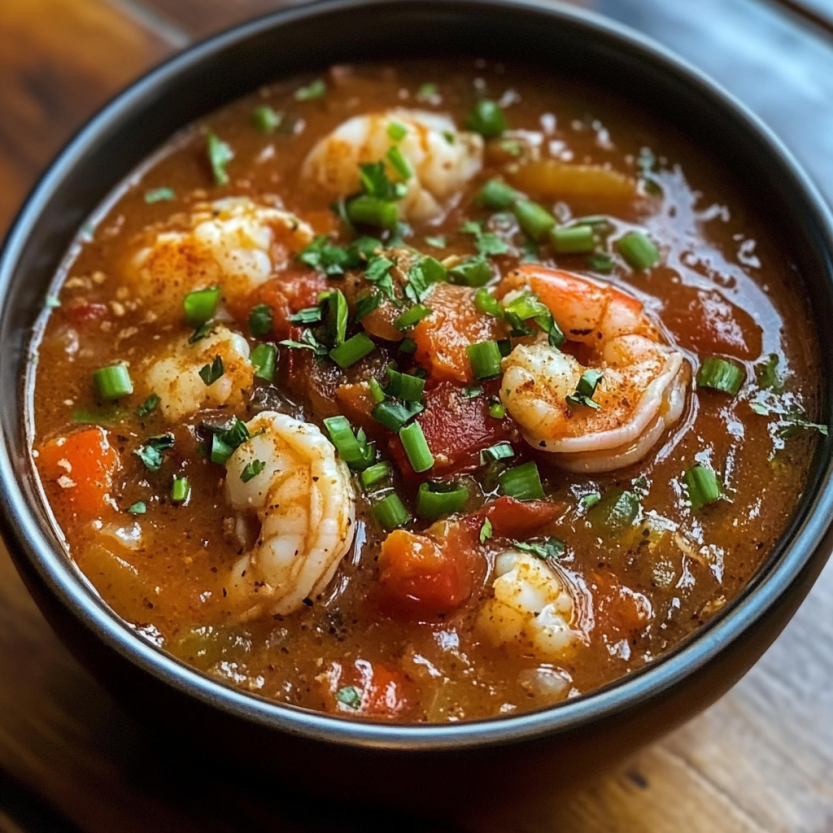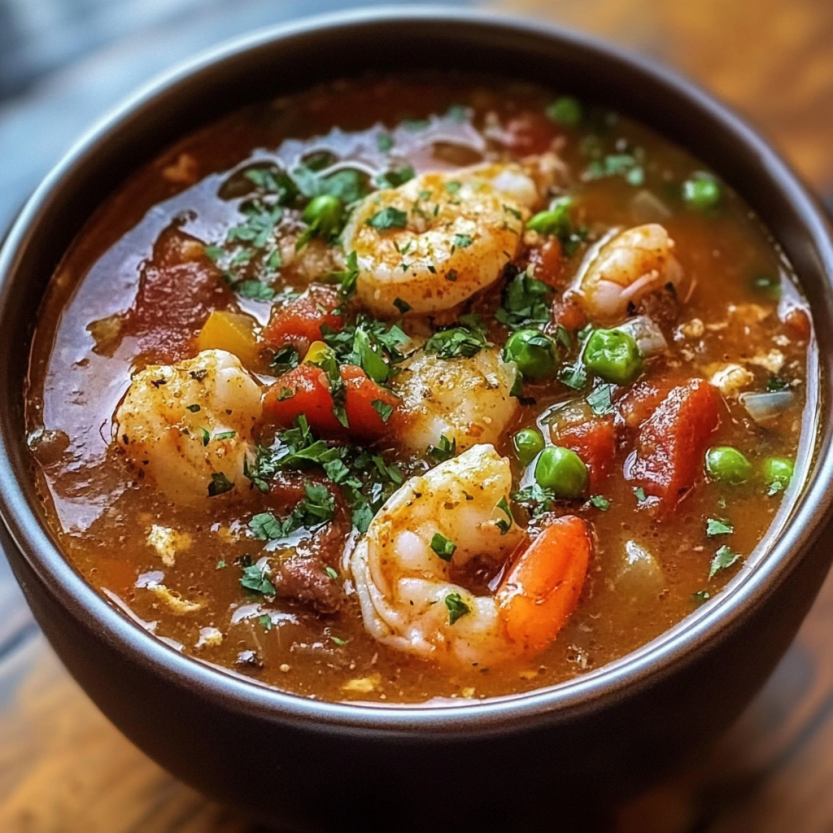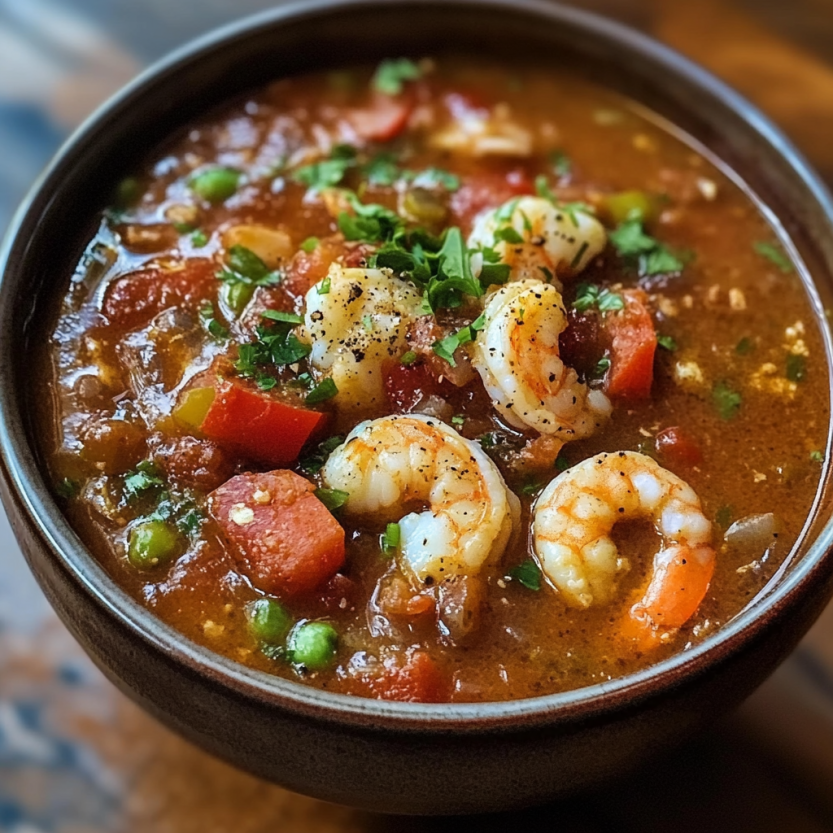 Save
Save
This hearty Louisiana Seafood Gumbo has been my go-to dish whenever I want to impress dinner guests with authentic Creole flavors. The combination of seafood and sausage simmered in a rich, dark roux creates a depth of flavor that's truly unforgettable.
I first made this gumbo during a rainy weekend when I was craving something comforting yet special. The rhythmic stirring of the roux became almost meditative, and the aroma that filled my kitchen transported me straight to New Orleans.
Ingredients
- All purpose flour: creates the foundation for your roux building deep nutty flavor
- Vegetable oil: paired with flour creates the essential thickening base
- Andouille sausage: adds smoky depth look for authentic Cajun varieties
- Fresh shrimp: provides sweet tender bites choose wild caught when possible
- Lump crab meat: adds delicate sweetness the splurge is worth it
- Bell pepper, celery, and onion: the Holy Trinity of Creole cooking
- Fresh garlic: adds aromatic punch use more if you love garlic
- Quality stock (chicken or seafood): homemade will elevate the flavor
- Okra: natural thickener with unique texture fresh is best when available
- Cajun seasoning: brings authentic flavor look for brands without excessive salt
- Bay leaves and thyme: key aromatic herbs that infuse the broth
Step-by-Step Instructions
- Make the Roux:
- This is the foundation of great gumbo. Combine flour and oil in a heavy bottomed pot over medium heat. Stir continuously without stopping for 20 30 minutes until the mixture transforms from white to blonde to peanut butter and finally to a chocolate brown color. Do not rush this step or let it burn. The darker the roux the deeper the flavor but watch carefully as it can burn quickly.
- Cook the Holy Trinity:
- Add the chopped bell pepper onion and celery to the hot roux. The vegetables will sizzle dramatically and immediately cool the roux preventing it from burning. Stir continuously for about 5 minutes until vegetables begin to soften releasing their aromatic qualities into the roux. Add garlic and cook for another minute until fragrant.
- Brown the Sausage:
- Add sliced andouille sausage to the pot allowing it to release its smoky oils into the mixture. Cook for about 5 minutes stirring occasionally until the sausage develops some color and its fat renders into the base. This step layers in essential savory depth.
- Build the Broth:
- Pour in the stock slowly while whisking continuously to prevent lumps from forming. Add bay leaves thyme and Cajun seasoning. The liquid will begin to thicken almost immediately. Bring to a gentle boil then reduce heat and simmer uncovered for 45 minutes allowing the flavors to meld and intensify.
- Add Vegetables and Simmer:
- Stir in okra and optional tomatoes. The okra releases natural compounds that further thicken the gumbo. Simmer for another 10 minutes until the okra softens but still maintains some texture. This stage allows the broth to reduce slightly concentrating the flavors.
- Incorporate Seafood:
- Add shrimp and crab meat to the pot. Simmer gently for only 5 7 minutes until shrimp turns pink and opaque. Overcooking seafood will make it tough so be vigilant during this final cooking stage. The delicate seafood should be added last to preserve its tender texture.
- Final Seasoning:
- Finish with Worcestershire sauce hot sauce and adjust salt and pepper to taste. These final additions brighten the rich flavors. Garnish with chopped green onions and fresh parsley which add color and a fresh counterpoint to the deep flavors of the gumbo.
 Save
Save
My grandmother always said the secret to great gumbo is standing by the pot. The first time I made this recipe I was tempted to walk away while stirring the roux and nearly ruined the whole dish. Now I treat making gumbo as a meditation keeping a watchful eye on that transforming roux the way she taught me.
The Secret of the Perfect Roux
The roux is the soul of any good gumbo. The longer you cook it the deeper the flavor becomes but also the less thickening power it has. For seafood gumbo I prefer a roux thats the color of milk chocolate not as dark as what youd use for a chicken and sausage gumbo. Keep the heat medium never high to prevent burning and use a wooden spoon with a flat edge to constantly scrape the bottom of the pot. Some Louisiana cooks call making roux building a house brick by brick you simply cannot rush it.
Regional Variations Worth Trying
In New Orleans you'll often find tomatoes in seafood gumbo while in other parts of Louisiana this would be considered sacrilege. Coastal communities might include oysters alongside the shrimp and crab. Some recipes use file powder a dried ground sassafras leaf instead of okra particularly when okra isnt in season. Each family has their own special twist on gumbo reflecting their heritage and local ingredients available. Consider trying these variations once youve mastered the basic recipe.
 Save
Save
Serving and Accompaniments
Traditional gumbo is always served over a small mound of white rice never mixed together until reaching the plate. Offer hot sauce on the side for those who want extra heat. Warm French bread with butter is the perfect accompaniment for sopping up the rich broth. For a complete Louisiana experience serve with a simple side salad dressed with oil and vinegar to cut through the richness of the gumbo. Some families also serve potato salad alongside or even sometimes right in the gumbo bowl a regional variation worth trying.
Storage and Reheating
Gumbo actually improves with time as the flavors meld together. Store leftovers in an airtight container in the refrigerator for up to 3 days. For longer storage freeze in portion sized containers for up to 3 months. When reheating do so gently over medium low heat adding a small amount of water or stock if needed to reach desired consistency. Be careful not to bring to a full boil when reheating especially with seafood gumbo as this can toughen the delicate seafood.
Recipe Questions
- → What makes a good roux for gumbo?
A good gumbo roux requires patience and constant stirring. Cook the flour and oil mixture over medium heat for 20-30 minutes until it reaches a deep chocolate brown color (but not black, which indicates burning). The darker the roux, the more flavor it adds, though it loses some thickening power. Never stop stirring during this process to prevent burning.
- → Can I substitute the seafood in this gumbo?
Absolutely! You can customize the seafood based on availability and preference. Try using crawfish, oysters, firm white fish like catfish, or even scallops. If seafood allergies are a concern, you can make a chicken and sausage gumbo instead by substituting chicken thighs for the seafood.
- → What's the difference between filé powder and okra in gumbo?
Both ingredients serve as thickeners, but they work differently. Okra adds thickness while cooking and provides a distinctive texture. Filé powder (ground sassafras leaves) is typically added at the end of cooking or at the table and loses its thickening properties if boiled. Some cooks use both, but traditionally, you'd choose one method based on seasonal availability of okra.
- → Can I make gumbo ahead of time?
Gumbo actually improves with time as flavors meld together. You can make it 1-2 days ahead but add the seafood only when reheating to serve. Simply bring the base back to a simmer and cook just until the seafood is done. Gumbo also freezes well without the seafood for up to 3 months.
- → What's the 'Holy Trinity' in Creole cooking?
The Holy Trinity is the foundational flavor base in Creole and Cajun cooking, consisting of equal parts chopped onion, celery, and green bell pepper. This aromatic mixture is similar to the French mirepoix (onion, celery, carrot) and is essential for authentic Louisiana dishes like gumbo, jambalaya, and étouffée.
- → What's the best side dish to serve with gumbo?
While gumbo is traditionally served over white rice, it pairs wonderfully with cornbread or French bread for sopping up the flavorful broth. A simple side salad with a tangy vinaigrette can provide a refreshing contrast to the rich gumbo. For a complete Louisiana experience, consider serving bread pudding with rum sauce for dessert.